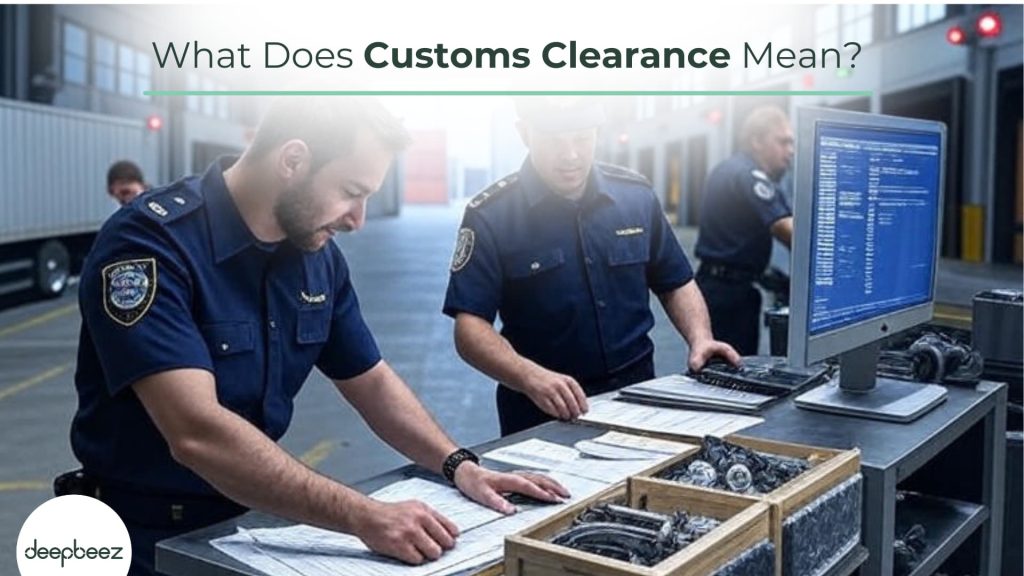What does customs clearance mean in shipping? in simple terms, every time goods cross a border, they need to go through customs clearance. Think of it as a country’s checkpoint where officials make sure everything entering or leaving follows the rules.
What happens during customs clearance process? Customs authorities inspect your items, verify they comply with local laws, calculate any taxes owed, and then release your goods to continue their journey. It’s their way of keeping everyone safe and making sure the proper duties get paid.
What is the first step to successfully getting customs cleared? Choosing the best and most accurate HS Code for your product. Deepbeez HS Code Search Tool will help you to take the first step correctly.
What Does Customs Clearance Mean?
Whether you’re a seasoned importer/exporter or just starting your global business journey, we all know that customs clearance can make or break your shipping timeline. if you want to reach the “Customs Clearance Completed” phase, you need to make sure that all fees, customs duties and tariffs are settled down.
Necessary Documents for Completing Customs Clearance
Let’s cut to the chase—these five documents form the backbone of almost every customs clearance process worldwide:
| Document | Purpose | Why It Matters to You |
| Commercial Invoice | Details the transaction, including goods description, quantity, value, and buyer/seller information | Customs uses this to calculate duties and taxes—accuracy here saves you money! |
| Packing List | Outlines contents of each package, specifying items, quantities, dimensions, and weight | Makes physical inspections faster and reduces the risk of delays |
| Bill of Lading | Serves as receipt from carrier and outlines transportation contract terms | Your proof that the carrier accepted your goods in good condition |
| Certificate of Origin | Certifies the country where goods were manufactured | Can qualify you for preferential tariff rates under trade agreements |
| Customs Declaration | Provides detailed information about imported/exported goods | The formal document that initiates the customs clearance process |
The specific documents required for customs clearance vary significantly depending on both the country where your goods originate and their final destination.
However, depending on your cargo, destination, and shipping method, you’ll need additional documentation. Think of these as your specialized tools for particular shipping scenarios:
| Document | When You’ll Need It | Pro Tip |
| Air Waybill | For air freight shipments | Contains tracking details—keep a copy handy for real-time status checks |
| Proforma Invoice | Before finalizing the shipment | Helps your buyer secure import approvals and arrange payment in advance |
| Insurance Certificate | For valuable or high-risk cargo | Request “all-risk” coverage for comprehensive protection |
| Transportation Invoice | When shipping costs are billed separately | Keep this handy for accurate landed cost calculations |
| Pre-shipment Inspection Certificate | For regulated goods or certain destination countries | Schedule inspections early to avoid last-minute scrambling |
| Certificate of Free Sale | For food, cosmetics, and health products | Obtain this from your industry regulatory body before export |
| Shipper’s Letter of Instruction | When using a freight forwarder | Be detailed—this document shapes how your shipment moves |
| Letter of Credit | For new business relationships or high-value shipments | Specify exact document requirements to prevent payment delays |
Import vs. Export Customs Checks: What’s the Difference?
What is customs compliance? Did you know customs officials look for different things when goods leave versus when they enter a country?
Export Customs Focus:
I’ll help you navigate export controls that prevent sensitive items from falling into the wrong hands. Export authorities check that regulated items like computers, textiles, and measuring devices—which could potentially serve military purposes—follow proper trade control orders.
Import Customs Focus:
When bringing goods into a country, expect stricter scrutiny. Here, you have to face import duties. Import authorities will verify:
- Your shipment contains no prohibited items (like illegal drugs)
- You’ve correctly declared the product origin
- Your tax declarations match the actual value
Pro tip: Import inspections typically run more stringent than export checks because countries prioritize protecting their borders and collecting proper revenue.
